Unless I take the time to carefully pluck them out, one by one, before taking a garden pic, you have probably noticed the indecent number of pine needles lurking in the background of EVERY PHOTO I TAKE!Once upon a time I had big dreams of chicken wire leaf bins in my backyard to effortlessly convert the sweet gumball and maple leaves raked up each fall into garden gold over the course of a year. In these fantasies I would empty the bins the following fall and add the compost to my garden before starting the cycle over again.Instead, the home I purchased has pine trees. Loblolly Pine trees (Pinus taeda) to be exact and the leaves they shed do not turn into lovely compost over the course of a year but instead, remain defiantly pine needle-like for much, much longer.After a bit of debate and confirming that pine needles making soil acidic is actually an old wives tale, I decided to compost them anyway (note: this was my idea, not the pine needles').Then, magically, after two years of composting, I have...pine needles!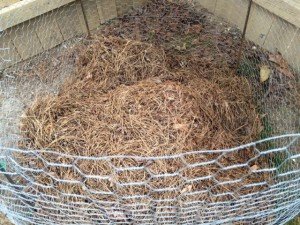 Pine needles don't turn into compost very quickly, but one of my goals this year is to mulch and I have been casting around for a sustainable, organic mulch that would work well in my garden beds. After two years of composting, I did get somewhat broken down needles that would work very well as a mulch.
Pine needles don't turn into compost very quickly, but one of my goals this year is to mulch and I have been casting around for a sustainable, organic mulch that would work well in my garden beds. After two years of composting, I did get somewhat broken down needles that would work very well as a mulch.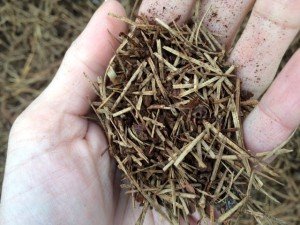 I started mulching around my transplanted collards while I wait for my direct sown spinach and sugar snap peas to fully sprout and I have to admit the result is quite nice.
I started mulching around my transplanted collards while I wait for my direct sown spinach and sugar snap peas to fully sprout and I have to admit the result is quite nice.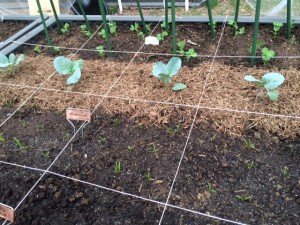 Because I have been turning the needles in their bin throughout the year, I know they hold moisture and attract earthworms so should work well as a mulch.
Because I have been turning the needles in their bin throughout the year, I know they hold moisture and attract earthworms so should work well as a mulch.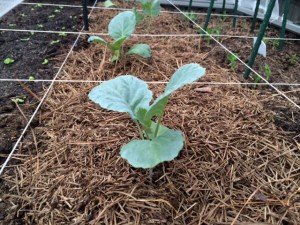 Okay, that was a completely gratuitous pic just because they looked so pretty.So now, I have made lemonade from my lemons and looking over my garden plan now I find myself in the position I could not have conceived of a year ago, I am not sure I have enough pine needles!
Okay, that was a completely gratuitous pic just because they looked so pretty.So now, I have made lemonade from my lemons and looking over my garden plan now I find myself in the position I could not have conceived of a year ago, I am not sure I have enough pine needles!
Trench Composting for Corn
I have never really wanted to grow corn since the small amounts I desire for home cooking are readily available at the farmer's market in season, it takes up a lot of valuable space in an already tight garden plan and it is an environmentally costly plant to grow. Corn is greedy. Really greedy.Then I promised my 8 year old that he could grow anything he wanted next year and flipping through a seed catalog he picked Strawberry Popcorn. I dutifully ordered the seeds and we were researching growing, harvesting and drying the variety online when we ran across our first glimpses of Glass Gem Corn. We marveled at the photos and videos of this varietal and were both smitten by its beautiful colors. When it appeared on the Baker Creek Heirloom cover a couple of weeks ago, I found myself suddenly preparing for two varieties of corn in spring 2016 but still didn't want corn in my garden proper.My suburban lawn is in its second year of organic management (no herbicides, pesticides or fertilizers are used) so the conundrum of what to do with the corn made me consider planting directly in the yard as a solution to the space requirements and soil depletion problems of corn. But although I don't use chemicals on the soil, that is not the same thing as having good, rich soil for growing anything. I had seen information on trench composting some time ago and decided to dig back in and learn a bit more.There are a lot of variations on trench composting from the fill it as you go style to the much more elaborate hugelkultur style installations. I opted for something closer to the style in the video below.https://www.youtube.com/watch?v=W1XmP9-RpmYI started with a trench and filled in a layer of browns. These are leaves and pine needles that have been composting for a year now. The leaves have already broken down into a rich soil structure but the pine needles take a bit longer.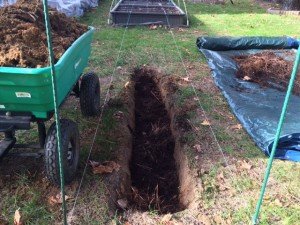 I followed the layer of browns with some rich, dark, nearly done compost from my two tumbling composters.
I followed the layer of browns with some rich, dark, nearly done compost from my two tumbling composters.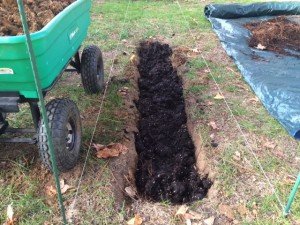 I topped the compost with another layer of the browns.
I topped the compost with another layer of the browns.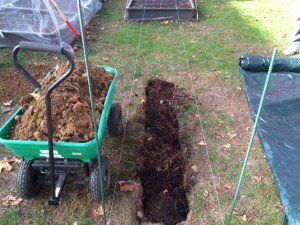 And finished it off by replacing a top layer of soil, mounding it up a bit since it will settle as the layers of browns and compost continue to biodegrade and compact.
And finished it off by replacing a top layer of soil, mounding it up a bit since it will settle as the layers of browns and compost continue to biodegrade and compact.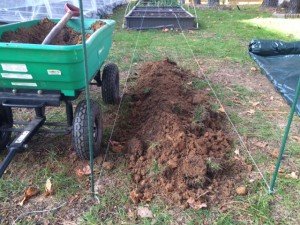 The Glass Gem Corn will be planted on either side of this trench in spring and I will need to do the same elsewhere in my yard for the Strawberry Popcorn. I hope to have a staggered planting system in years ahead where I grow on top of a trench a year and a half after it is filled with rich, organic matter that has had time to be broken down by microbial and worm activity.
The Glass Gem Corn will be planted on either side of this trench in spring and I will need to do the same elsewhere in my yard for the Strawberry Popcorn. I hope to have a staggered planting system in years ahead where I grow on top of a trench a year and a half after it is filled with rich, organic matter that has had time to be broken down by microbial and worm activity.
Haystack of Needles
It has been raining two things since Thursday night. Raindrops and pine needles.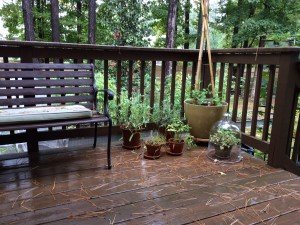 Going into my second fall as a North Carolina gardener, I have started calling them Piedmont sand because they are a pain to clean up and get into absolutely everything!Last year I made a leaf composting bin to reduce yard waste and build soil with all the sweet gumball leaves that fall into my backyard. With each infusion of leaves, pine needles inevitably found their way into the bin also and they take much longer to break down. After a year of compositing and being filled to the brim with leaves no less than 4 times, I am left with a small pile of garden gold mixed in with a small haystack of needles.
Going into my second fall as a North Carolina gardener, I have started calling them Piedmont sand because they are a pain to clean up and get into absolutely everything!Last year I made a leaf composting bin to reduce yard waste and build soil with all the sweet gumball leaves that fall into my backyard. With each infusion of leaves, pine needles inevitably found their way into the bin also and they take much longer to break down. After a year of compositing and being filled to the brim with leaves no less than 4 times, I am left with a small pile of garden gold mixed in with a small haystack of needles. There is conflicting information on whether pine needles add a significant amount of acidity to the soil as they break down or not so to be safe, this mixture will be used to compost around my acidity loving blueberry bushes.I am reasonably certain that the 8 pine trees in my backyard are Pinus taeda, the loblolly pine. They will shed needles almost continuously from now until spring. This year's needles will be used to mulch around the magnolia tree, which also likes a bit of acidity, after being broken down a bit with a weed wacker to speed up the decomposition.I hope to find a happy balance between the amount of needles the trees can produce in a two year span and the amount of pine needle compost/mulch I can use.
There is conflicting information on whether pine needles add a significant amount of acidity to the soil as they break down or not so to be safe, this mixture will be used to compost around my acidity loving blueberry bushes.I am reasonably certain that the 8 pine trees in my backyard are Pinus taeda, the loblolly pine. They will shed needles almost continuously from now until spring. This year's needles will be used to mulch around the magnolia tree, which also likes a bit of acidity, after being broken down a bit with a weed wacker to speed up the decomposition.I hope to find a happy balance between the amount of needles the trees can produce in a two year span and the amount of pine needle compost/mulch I can use.
Getting The Most From Your Harvest
For urban growers, getting the most production out of the smallest space possible is an absolute priority! I can grow a lot in my 224 sq ft space, but there are ways of making what you grow give you even more.One of my favorite methods of getting more is to harvest leaves, but allow the plant to regenerate and keep growing more leaves. Not all garden plants are suitable to this, but if it is an herb or vegetable you grow for the leaves, chances are that you can.Some of my favorite plants to steal from are cilantro, chard, spinach, lettuce, basil, oregano, rosemary, sage, thyme and parsley and you can do this even when they are quite young. The trick is to only steal a little from each plant so the plant can recover and continue to grow.Below are my young cilantro plants. I choose the largest, oldest leaves from furthest down the plant stem to leave the fresh young growth undisturbed and pinch off one or two from each plant or as much as is needed for a meal. The spinach is more mature but I still want to keep the plants growing and only harvest what I need right before a meal.
The spinach is more mature but I still want to keep the plants growing and only harvest what I need right before a meal.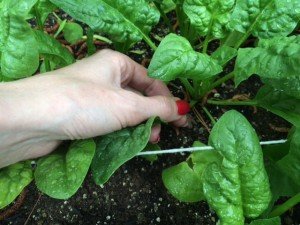 There is nothing fresher than still warm from the sun or wet from the rain.
There is nothing fresher than still warm from the sun or wet from the rain. Who says you can't have your plants and eat them too :)*Note - even those little cilantro and spinach stems will be put to good use either as flavorings for stocks or to into the compost.
Who says you can't have your plants and eat them too :)*Note - even those little cilantro and spinach stems will be put to good use either as flavorings for stocks or to into the compost.
Extensive Gardening
If you are not familiar with the terms extensive and intensive, they can be a bit misleading. Extensive doesn't mean large, it means requiring little or no additional inputs (fertilizer, compost, labor, etc.) and intensive doesn't mean working hard, it means using a lot of those same inputs. A great primer on the differences can be found here.For my initial garden set up, it was intensive. I purchased the raised beds, the materials to make soil (compost, vermiculite and peat moss) and seeds. But once it is set up, I was able to become much more extensive. I save seeds, any part of the plants that do not end up on a dinner plate go into the compost to feed the next generation, seedlings that need to be thinned have those same two options - food or compost, or as my son says "the circle of life".I still have water as a major input when the skies aren't doing the watering for me and I still have to buy some seed, but otherwise it is a pretty closed cycle with most of what my garden needs coming from my garden and yard. I have looked into the rain barrel collection options but I am not convinced that water that has run off a petroleum based shingle roof is a good idea for growing my food.In the meantime, more and more people like me, who have a generational disconnect from the conventional farming ways of our grandparents and great-grandparents are taking up farming and urban farming. With this new generation of growers we are seeing an entirely new set of best practices and innovative ideas. Maybe someday soon I will be able to have a completely closed system.
Spinning Gold
Fall fell on the Triangle region while I was in New Orleans and the pace of leaf drop from the trees in my back yard is picking up speed. The water and light permeable row covers I have over my collards and spinach is doing a great job of protecting the beds from litter.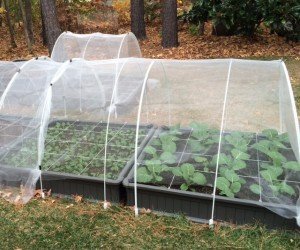 But what to do with all of those leaves? I have more leaves than I could possibly mix in my compost bins since I had a late start to my gardens this year and I just don't have the greens to off-set the carbon.A few years ago I had seen an episode of Ask This Old House with Roger Cook talking about making leaf bin out of fencing to let the leaves compost on their own into leaf mold. This seemed a better use of the nutrients falling on my garden than curbside pickup so a quick trip to Lowe's later, I set up my own leaf bin.
But what to do with all of those leaves? I have more leaves than I could possibly mix in my compost bins since I had a late start to my gardens this year and I just don't have the greens to off-set the carbon.A few years ago I had seen an episode of Ask This Old House with Roger Cook talking about making leaf bin out of fencing to let the leaves compost on their own into leaf mold. This seemed a better use of the nutrients falling on my garden than curbside pickup so a quick trip to Lowe's later, I set up my own leaf bin.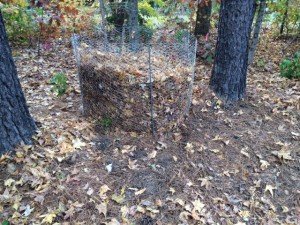 It blends perfectly into the landscape and is currently holding .2 acres worth of leaves. Because I have a healthy amount of pine needles mixed in with the leaves, I took it one step further and used my weedwacker as as immersion blender to help get the process started by breaking down some of the leaves and needles as well as creating a little more room on top for round two which is sure to happen next weekend.I only purchased 4 rebars to do one bin but I have enough chicken wire left to do at least two more if I need to. All in all, a fun project with an attractive result that will give me gardening gold for my plants next year.
It blends perfectly into the landscape and is currently holding .2 acres worth of leaves. Because I have a healthy amount of pine needles mixed in with the leaves, I took it one step further and used my weedwacker as as immersion blender to help get the process started by breaking down some of the leaves and needles as well as creating a little more room on top for round two which is sure to happen next weekend.I only purchased 4 rebars to do one bin but I have enough chicken wire left to do at least two more if I need to. All in all, a fun project with an attractive result that will give me gardening gold for my plants next year.